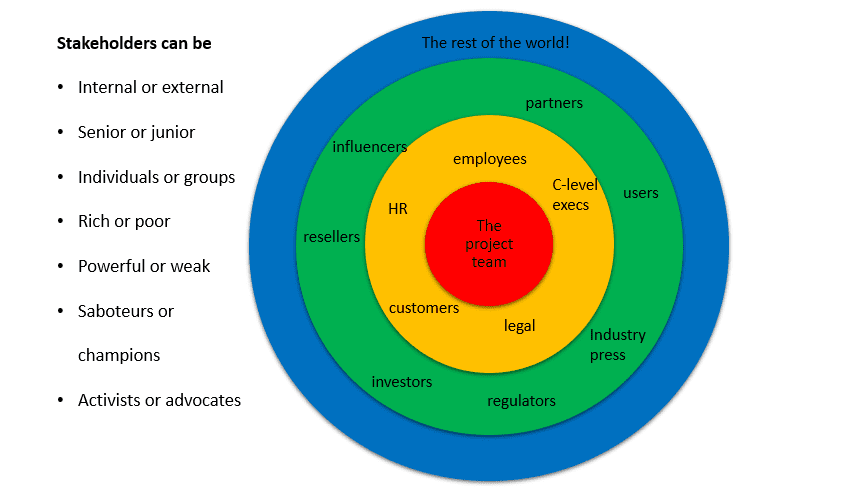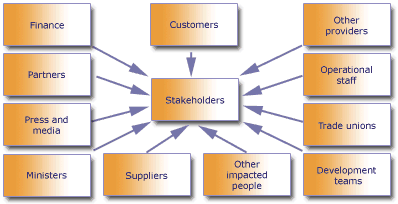What is a Stakeholder?
A stakeholder is anybody who can affect or is affected by an organization, strategy or project. They can be internal or external and they can be at senior or junior levels. stakeholdermap.com

'People or small groups with the power to respond to, negotiate with, and change the strategic future of the organization' (Eden and Ackermann 1998: 117).As Bryson states this is a somewhat restrictive definition because it excludes those who are affected, but who don't any power to respond to or negotiate with an organization. Bryson prefers a more inclusive definition which extends to all people who are affected by a change, this wider meaning is more compatible with notions of democracy and social justice. (Bryson 2004: 22).
'any group or individual who can affect or is affected by the achievement of the organization's objectives' (1984: 46).I agree that a wider definition is preferable, but not just for ethical reasons. projects whether small or large will impact people who don't have power during the implementation, but may do so in business as usual.
Remember to include peope who feel positive, they might help you sell or market the benefits of your project.
For example, call center staff may not have a choice in the procurement or implementation of a CRM system, but can be the key factor in the long-term adoption of the software. If call center staff don't fully adopt the software, if they don't use it's full capabilities then they impact senior managements' perception of the software and it success or failure. Disgruntled call center staff could prevent achievement of ROI which would ultimately result in the software being replaced. Therefore stakeholder identification must include those who may at first appear to be powerless.
Stakeholders can be:
Deciding on the definition that you will use is an important choice that will drive your entire strategy. To help you decide, see more definitions at What is a Stakeholder?
- Internal or external to your business
- At Senior or junior level
- Individuals or groups
- Rich or poor
- Powerful or weak
- Saboteurs or champions
- Activists or advocates
How to identify your stakeholders
Stakeholders are crucial to the success of your project. Neglect them and they will actively work against you. Manage them well and they will actively promote you and your project (stakeholdermap.com)The first step in is to identify your stakeholders. Get your project team together and list everybody that you can think of who is, or will be affected by the project.
Tools and techniques

Brainstorming
Is a great way to identify stakeholders. Ask someone to be the scribe and capture every name, organization and group you can think of. Alternatively you could give everybody a pad of sticky notes and ask them to write as many stakeholders as they can think of using one note per stakeholder. After 10 - 15 minutes put up the sticky notes on the wall or on flipchart paper. Read more on how to use brainstorming.Mind mapping
Is also a useful way of unlocking your creativity and helping the ideas to flow. Your scribe can draw a mind map on a whiteboard or flipchart or you can use 'mind-mapping' software. See an example stakeholder mindmap for a software implementation project. There are many online and desktop providers of mindmapping software, offering free and paid options. A web search for 'mindmapping software' will find plenty of suggestions. We use mindmeister.com.Stakeholder lists
Generic lists are a good starting point to identify potential stakeholders. This list suggests 105 stakeholders and you are welcome to use it. It is a generic list so it doesn't include many specialist or industry specific job titles, that said we hope it will be a useful to kick off your stakeholder mapping! For industry specific lists see BPM stakeholders, big data stakeholders, construction stakeholders, ecommerce stakeholders, IT stakeholders, ITIL stakeholders and government stakeholders. For projects see project stakeholders.Previous projects
Search documentation from previous projects and talk to project teams to identify people likely to be involved for a particular project type or a particular client. You may be able to refer to a stakeholder map or glean stakeholders from project plans, PIDs, risk logs and so on. The ebook includes two completed stakeholder analyzes, one for a software project and one for a university construction project.Organization charts and directories
Perhaps the first place to look for stakeholders is your company organization chart or directory. Interesting insights can also be gained by reviewing LinkedIn and social network sites. For example, use advanced people search on LinkedIn to filter by company, industry, job title, and/or seniority.Stakeholder Categories
If you are struggling you could try using categories to identify potential stakeholders. For example the OGC suggest that it can be helpful to organise people by the following categories:- users/beneficiaries:
- customers
- staff
- freelancers
- contractors
- governance:
- board of directors
- steering groups
- project boards
- audit
- regulatory
- influencers:
- trade unions
- media
- local interest groups
- providers:
- suppliers
- partners
What is a Stakeholder mindmap
Create your own version of this mindmap.
Step 1 - Click here to download the map to your computer. Extract all files.The mindmap above is adapted from OGC, Managing Success Programmes, London: TSO, 2007 pg. 51.
Step 2 - Create your Mindmeister account.
Step 3 - Import Stakeholder_Identification.mind.
There are eight (8) other mindmaps in the zip folder which you are free to use. 23 bonus mindmaps are included with Stakeholder Management ebook.





